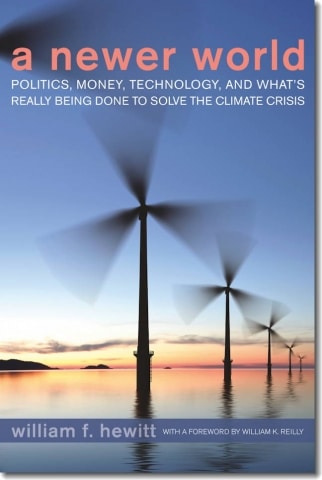The following is excerpted from A Newer World: Politics, Money, Technology, and What’s Really Being Done to Solve the Climate Crisis by Bill Hewitt. It is taken from Chapter 8, “A Resilient Future: Adaptation, Education, Law, and Lifestyle.” The analysis of the insurance industry’s response to climate change below does not reflect the latest information such as the fact that Hurricane Sandy caused an estimated $28.2 billion in insured losses and approximately $65 billion in economic losses across the US, Caribbean, Bahamas and Canada.
The Insurance Industry’s Response
One industry that knows what is coming is insurance. We looked at insurance in Chapter 5, noting how fully convinced all the leaders in the industry are of climate change’s impacts, now and for the future, and how committed they are to managing those risks through pushing for policy to meet the crisis head-on and by promoting measures to effectively adapt to the inevitable stresses on human populations and infrastructure that are at hand. The Insurance Information Institute cites one study on hurricanes that indicates that as wind speeds increase over the next couple of decades, property insurance losses will increase as well — by 30 to 40 percent. Seven of the ten most costly hurricanes in U.S. history occurred from August 2004 to October 2005, including Katrina, which caused losses of $41 billion. If the predictions of more-intense storms bear out, with the attendant increases in property loss, then Katrina will be dwarfed in the future, especially if hurricanes zero in on major cities in the United States like Miami or New York. The Big Apple had a near miss with disaster in late August 2011 with Hurricane Irene.
Because of the risks, insurers have raised the ante for companies and individuals. The threshold for capital adequacy for companies is much higher, and the risk from losses from two disasters happening in quick succession must be considered.
Beyond this, insurers are simply pulling out of high-risk areas. Allstate, the third-largest player in the United States, has been reducing its exposure in hurricane zones and in areas subject to cyclones and other inland storms. Allstate’s CEO, referring to more-intense storms, has said: “We’re running our business as if this change … is permanent. We don’t know whether the genesis of that increase over the last three years is just a cyclical movement in weather, whether we’re to ‘normal’ or we were at ‘normal’ before, or it’s global warming or anything else, but we’re acting as if this will be permanent and we need to recover those costs.”
As terrible as loss of life and property damage may be for communities in the developed world, it is exponentially worse for those in the developing world. These populations often have minimal shelter, limited food and water resources, poor or, in many cases, nonexistent infrastructure, and, what is a particularly pernicious factor in a catastrophe, inept, corrupt, and indifferent governance. Witness the disaster in Myanmar (Burma) in 2008 that ensued from the landfall of Cyclone Nargis and the resistance by the military government to offers of aid by the international community. Certainly the lack of preparedness and the meager response by the junta as well as its initial blocking of outside aid contributed to the massive loss of life that numbered near 140,000.
In any event, the insurance industry is among those who have taken a lead role in helping developing world communities to adapt to the many difficult climate change impacts to which they are subject. In 2005, Munich Re launched the Munich Climate Insurance Initiative (MCII). In 2010, MCII joined with three other groups, with membership among them of over one hundred major international insurance firms. They issued a statement with concrete proposals for governments to adopt in order to help developing countries adapt. The insurance companies want to “catalyse adaptation efforts through risk management, loss prevention and risk transfer.” They offer various successful models such as the Caribbean Catastrophe Risk Insurance Facility and Horn of Africa Risk Transfer for Adaptation as indications of how effective these sorts of approaches can be. The companies have made a commitment to provide their expertise and to deliver information and advice on options, developing new insurance products, and raising awareness among stakeholders.
Ceres, the investment responsibility group, looked at the industry a few years ago and even then counted over six hundred climate initiatives ongoing at nearly 250 companies worldwide.
Order your copy of A Newer World today at upne.com to read more of Bill Hewitt’s excellent new book.
Excerpted with permission from the publisher, University of New Hampshire Press. Copyright © William F. Hewitt, 2012. www.upne.com
Subscribe to our newsletter
Stay up to date with DeSmog news and alerts







